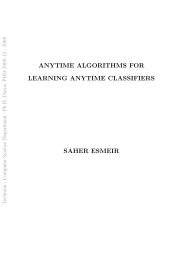Computing Extremal Quasiconformal Maps - Technion
Computing Extremal Quasiconformal Maps - Technion
Computing Extremal Quasiconformal Maps - Technion
You also want an ePaper? Increase the reach of your titles
YUMPU automatically turns print PDFs into web optimized ePapers that Google loves.
O. Weber & A. Myles & D. Zorin / <strong>Computing</strong> <strong>Extremal</strong> <strong>Quasiconformal</strong> <strong>Maps</strong><br />
Discussion. By construction, the quadratic differential computed<br />
by the algorithm is discrete holomorphic and the corresponding<br />
Beltrami coefficient has constant dilatation k. At<br />
the same time, the actual Beltrami coefficient of the map<br />
f¯z/ fz is just an approximation to the “perfect” computed coefficient.<br />
We note that in general, if ˆµ (i.e. the angular part<br />
of µ) is fixed, this determines the parametrization uniquely<br />
with no control for k on each triangle.<br />
While we observe good convergence of the algorithm to<br />
constant k in L 2 norm when the mesh is refined, this does not<br />
guarantee that k < 1 (i.e. there are no fold-overs) on all triangles,<br />
even for a very fine mesh. In practice, we observe that<br />
no triangles are flipped for a sufficiently fine mesh, excluding<br />
few triangles near highly concave parts of the boundary.<br />
In the next section, we present a detailed evaluation of the<br />
behavior of the algorithm: dependency on the starting point,<br />
convergence rates, comparison to analytic cases.<br />
5. Evaluation<br />
Validation. We validate our method in several ways. The<br />
most direct validation is comparison to analytically computed<br />
maps. Unfortunately, the analytic solution is known<br />
explicitly only in few cases. We consider two maps known<br />
analytically: mapping a disk to itself with four boundary<br />
points moved to different locations, and mapping of a ring<br />
to a ring with a different ratio of inner to outer radius. In the<br />
first case, we consider maps moving points at angular locations<br />
±π/4,π ± π/4 on a circle, to ±φ,π ± φ. This map is<br />
given by<br />
fφ(z) = e −iφ <br />
F ze iφ ,e −2iφ<br />
where F(z,w) is the incomplete elliptic integral of the first<br />
kind. For the ring domain with inner and outer radii r0 and<br />
r1, mapped to a ring with inner and outer radii r ′ 0 and r′ 1 , the<br />
extremal map has the polar coordinate form<br />
(r,φ) → (r ′ 0(r/r0) K ,φ)<br />
where K = ln(r ′ 1 /r′ 0 )/ln(r1/r0). In both cases, we observe<br />
an accurate match both for the maps, and extremal dilatation<br />
values.<br />
We can also compute a subclass of Teichmüller maps<br />
semi-analytically, by prescribing a pair of conformal maps,<br />
and a stretch in the intermediate domain. We tested our<br />
method for both analytically and semi-analytically computed<br />
maps (Figure 7).<br />
In analytic cases, the maps are very close to exact ones.<br />
As the piecewise linear maps cannot in general have constant<br />
dilatation, we consider the deviation from the correct<br />
constant k as a measure of error, shown in the figure.<br />
Convergence in the general case. While the optimal dilatation<br />
cannot be computed for general boundary conditions,<br />
one can estimate the rate at which the deviation of dilatation<br />
k from the average value decreases. We observe a similar<br />
behavior for this measure shown in the last two examples<br />
in Figure 7. The number of iterations needed to reach 1%<br />
relative change in energy was typically on the order of 10<br />
c○ 2012 The Author(s)<br />
c○ 2012 The Eurographics Association and Blackwell Publishing Ltd.<br />
k error<br />
0.0004<br />
k error 0.022<br />
k error 0.0037<br />
k error<br />
0.014<br />
k error<br />
0.0026<br />
60<br />
40<br />
20<br />
0<br />
0 0.5 1<br />
100<br />
50<br />
0<br />
0<br />
60<br />
0.5 1<br />
40<br />
20<br />
0<br />
0 0.5 1<br />
80<br />
60<br />
40<br />
20<br />
0<br />
0<br />
80<br />
60<br />
40<br />
20<br />
0.5 1<br />
0<br />
0 0.5 1<br />
Figure 7: Top 3 examples: comparison to extremal quasiconformal<br />
maps. A disk with four points moved along the<br />
boundary, a ring with a change in the ratio of inner-to-outer<br />
radius, and an example of a map computed as a composition<br />
(3). This example shows a comparison of the map directly<br />
computed as the composition (left) with the map computed<br />
using our algorithm (middle). For each example, a histogram<br />
of k is shown, with percentages of triangles along the<br />
vertical axis. The last two examples use prescribed boundary<br />
values not corresponding to a known map.<br />
(in some cases, such as the ring domain, as low as 2-3). On<br />
the other hand, more complex and extreme deformations required<br />
more iterations.<br />
As expected, we observe that zeros of the quadratic differential<br />
become visible in the map (e.g., as shown in Figure 9).<br />
Dependence on initialization. As our algorithm minimizes<br />
a nonlinear energy, in principle the result may depend on the<br />
starting point. However, we observe very little dependence,<br />
as demonstrated in Figure 10.











